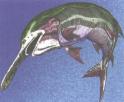The Paddlefish-The Floodplain Fish
 My wife and I are blessed by living in a house located on the St. Joseph
River. The river has many unique properties, and one of those properties
is the flattened overflow areas along the edge of the river called the flood
plain. When the river gets high, its waters flow across these flattened areas
along the river and thus reduce the flow and chances of flooding downstream.
My wife and I are blessed by living in a house located on the St. Joseph
River. The river has many unique properties, and one of those properties
is the flattened overflow areas along the edge of the river called the flood
plain. When the river gets high, its waters flow across these flattened areas
along the river and thus reduce the flow and chances of flooding downstream.
The flood plain is a good factory because the waters are fertile, having picked up organic debris of all kinds in its increased volume with rain or snow melt. Massive amounts of plankton grow in this warm and quiet water. These plankton feed many different animals and even a few plants, but they can overpopulate and unbalance an ecosystem. The paddlefish maintains this balance by consuming massive quantities of plankton. A full grown paddlefish can grow to six feet in length and weigh as much as 150 pounds. The paddlefish gets its name from its long snout that is shaped somewhat like a paddle. The snout is huge--a six-foot paddlefish would have a two-foot-long snout. It is riddled with thousands of tiny electroreceptors that are so sensitive that they can pick up an electric field of less than a hundred millionth of a volt per centimeter of length. When Daphnia or other small creatures move, their bodies send out a weak electric field. The paddlefish uses this field to find the animal and eat it. Since sight is not used, the paddlefish can function in the muddiest waters.
Paddlefish are found in America and in China. They are another example of remarkable equipment that enables a life form to thrive in a special environment and to benefit that environment and the life forms that depend on it for survival. Chance is an unworkable cause for equipment so unique, highly specialized, and technically sophisticated. God shows us His wisdom and engineering ability in such beautiful creatures as this one.
--Reference: Nature Conservancy, July/August, 2001, page 10.
Back to Contents Does God Exist?, SepOct02.